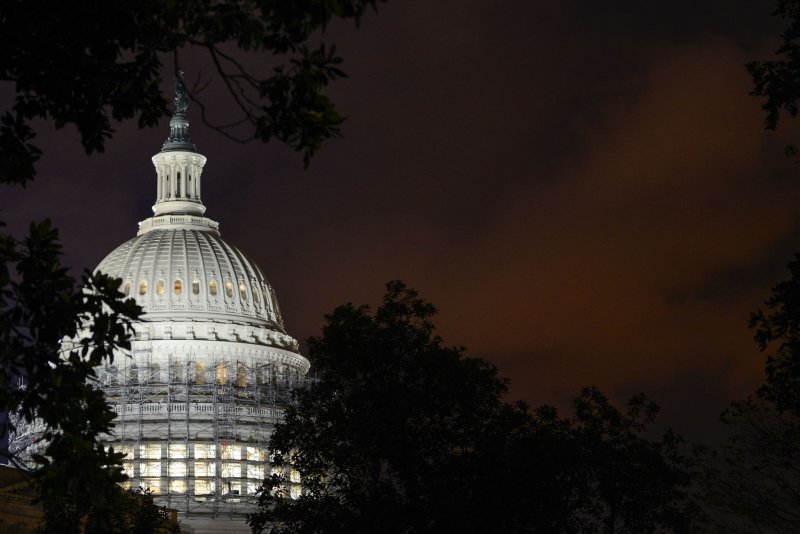With Hillary Clinton opening a significant lead in the presidential race, the campaign focus is turning to a handful of key congressional races, where Republicans hope to be able to convince voters skeptical of Donald Trump to still cast votes for the GOP in down-ballot races. Control of Congress could rest in the balance. Photo by Leigh Vogel/UPI |
License Photo
WASHINGTON, Oct. 11 (UPI) -- With polls showing the presidential race tipping toward Hillary Clinton in the wake of Donald Trump's struggle to recover from an embarrassing video, some of the attention in the 2016 election has shifted to control of Congress, where Democrats have a reasonable chance of retaking the Senate, but face longer odds in the House.
Republicans now hold a four-seat majority in the U.S. Senate, but are defending significantly more competitive seats than Democrats.
Control of the Senate will be decided with the outcome of competitive races in nine states -- and seven of them feature Republican incumbents trying to hold on.
The nine races generally seen as the most competitive this year include:
-- New Hampshire, where GOP Sen. Kelly Ayotte is in a tight race with the state's Democratic Gov. Maggie Hassan. The Real Clear Politics polling average of that race shows Ayotte leading by 2 points.
-- Pennsylvania, where GOP Sen. Pat Toomey is locked in a virtual tie with Democrat Katie McGinty. The RCP average favors Toomey by less than a point.
-- North Carolina, where GOP Sen. Richard Burr is locked in a virtual tie with Democrat Deborah Ross. The RCP average favors Burr by less than a point.
-- Florida, where GOP Sen. Marco Rubio enjoys a slight lead in the RealClearPolitics 30-day average of all polls of 4.4 percent over Rep. Patrick Murphy, a Democrat.
-- Wisconsin, where former Sen. Russ Feingold, a Democrat, is leading incumbent GOP Sen. Ron Johnson by 3.3 points in the RCP average.
-- Indiana, an open seat race where former Sen. Evan Bayh, a Democrat, leads Republican Todd Young by 4 points in the RCP average.
-- Illinois, where GOP Sen. Mark Kirk trails Democratic Rep. Tammy Duckworth by 7 points in the RCP average, representing the best chance for a Democratic pickup.
-- Missouri, where polling has been thin, but it's believed GOP Sen. Roy Blunt holds a slim lead on Democratic challenger Jason Kander.
-- Nevada, an open seat race where GOP Rep. Joe Heck leads Democrat Catherine Cortez Masto by 3.4 points in the RCP average.
Democrats had also hoped to mount a stiff challenge to GOP Sen. Rob Portman in Ohio, but former Gov. Terry Branstad trails by double-digits in that race and it is now generally rated as a Republican-leaning seat.
If Feingold and Duckworth can hold on to the leads they have maintained through much of the campaign in two normally blue states, that leaves seven more up for grabs. If Democrats can win three, they will assure themselves of a 51-49 Senate majority regardless of the outcome of the presidential election. If Hillary Clinton wins the presidency, her running mate Tim Kaine would serve as the tie-breaking vote, meaning Democrats could go two-for-seven and still claim a 51-50 majority.
The polling site FiveThirtyEight.com gives Democrats a 54 percent chance of retaking control of the Senate.
In the House, the path to a Democratic majority is much longer, thanks to the large cushion Republicans already enjoy. Democrats must overcome a GOP advantage of 59 seats, 247-188.
Democrats have previously said winning back the House would be virtually impossible in one election cycle, but have recently begun to express optimism the previously unthinkable could be within reach, though it would take a blue wave sweeping from coast to coast.
The nonpartisan Cook Political Report lists 17 House races as a pure toss-up. In order to retake the House, Democrats would need to sweep 13 districts that are already leaning their way, all 17 toss-ups and still win another 12 races that are leaning Republican to obtain a one-seat majority, 218-217.
The Washington Post reported Democrats are targeting 26 districts where Republicans are the incumbent, but President Barack Obama won four years ago -- along with another 23 GOP districts that Obama narrowly lost. Viewed through that lens, Democrats would still come up short, even if they won all 49 of those seats.
The presence of Donald Trump at the top of the Republican ticket has at least given Democrats some hope -- and Republicans some anxiety -- about their prospects in the House. In a sign of just how nervous some in the GOP are, House Speaker Paul Ryan told colleagues on Monday he will no longer campaign for Trump and instead will focus solely on retaining his House majority.
Trump's support has fallen in the days since a video was released of him speaking crudely about groping women and Democrats have sought to use Trump as a wedge, forcing Republicans across the country to take sides. The issue puts GOP candidates in a no-win situation: Either denounce Trump and potentially alienate his loyal base within the Republican Party, or embrace him and risk turning off moderates and women.
In response, Ryan urged Republicans in competitive races to campaign on local issues and their own record of accomplishments in Congress -- or turn the prospect of a Clinton victory into a method of energizing support by arguing voters should split tickets and elect Republicans to provide a check against her presidency.















